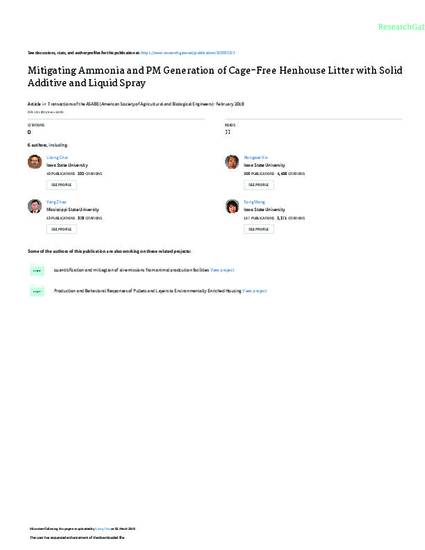
A number of chain restaurants, retailers, and grocers in the U.S. have pledged to source only cage-free (CF) eggs in the foreseeable future (e.g., by 2025) due to marketing reasons or concerns over animal welfare. However, CF housing has some inherent challenges, and a predominant one is poor air quality, i.e., ammonia gas (NH3) and particulate matter (PM), and increased emissions. Spraying a liquid agent such as electrolyzed water (EW) can effectively suppress PM generation of CF henhouse litter. However, liquid spray can enhance NH3 generation because it increases the litter moisture content (LMC). Application of acidic liquid to the litter would help control NH3 while suppressing PM, but con-cerns arise about the potential corrosive effect of acidic liquid on housing equipment. To overcome this dilemma, this study evaluated the effect of applying PLT, a commercial poultry litter additive (LA), on NH3 emissions of CF hen litter while spraying it with neutral EW (NEW) at a rate of 25 mL kg-1 dry litter d-1. The PLT application rates were 0.3, 0.6, and 0.9 kg m-2, denoted as Low-LA, Med-LA, and High-LA, respectively. CF litter was placed inside dynamic emission chambers and automatically stirred to mimic hen scratching. PLT was topically applied onto the litter on day 1; NEW was sprayed daily for 11 d, followed by a 3 d non-spray period (i.e., 14 d per trial); and each regimen was replicated four times. The ammonia emission rate (ER) of the control (no LA), Low-LA, Med-LA, and High-LA regimens (mean SE) was, respectively, 0.76 0.05, 0.55 0.06, 0.37 0.04, and 0.16 0.02 g kg-1 dry litter d-1, i.e., 28% to 79% reduction by the treatments. The NH3 reduction efficiency was linearly proportional to the PLT application rate, with higher application rate resulting in lower litter pH (p < 0.05). At the end of each trial (d14), the Med-LA and High-LA regimens still showed relatively low NH3 emissions, suggesting the need for a longer measurement period in future studies. The NEW spray increased LMC by up to 60% after 11 once-a-day sprays, which reduced PM2.5, PM10, and TSP levels from 3.83, 6.39, and 7 mg m-3 to 0.07, 0.14, and 0.15 mg m-3, respectively. After a 3 d spray suspension, the PM levels rebounded to 0.72, 1.02, and 1.12 mg m-3 for PM2.5, PM10, and TSP, respectively, due to decreased LMC. Field verification of the mitigation efficacy and an economic assessment of the method are warranted.
Available at: http://works.bepress.com/michelle_soupir/70/

This article is published as Chai, L., Y. Zhao, H. Xin, T. Wang, M. Soupir, and K. Liu. Mitigating ammonia and PM generations of cage-free henhouse litter with solid additive and liquid spray. Transactions of the ASABE 61, no. 1 (2018): 287-294. DOI: 10.13031/trans.12481. Posted with permission.